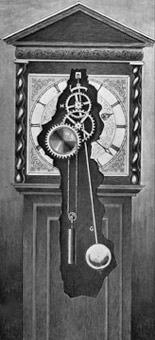Accurate Mechanical Clocks

In Europe during most of the Middle Ages (roughly 500 to 1500 A.D.), technological advancement was at a virtual standstill. Sundial styles evolved, but not far from ancient principles.
Then, in the early-to-mid-14th century, large mechanical clocks began to appear in the towers of several large Italian cities. These clocks that were weight-driven and regulated by a verge-and-foliot escapement. Like water flow, the rate was difficult to regulate.
Another advance was the invention of spring-powered clocks between 1500 and 1510 by Peter Henlein of Nuremberg. They slowed down as the mainspring unwound.
Pendulum Clocks
 |
In 1656, Christiaan Huygens, a Dutch scientist, made the first pendulum clock, regulated by a mechanism with a “natural” period of oscillation. Although Galileo Galilei, sometimes credited with inventing the pendulum, studied its motion as early as 1582, Galileo's design for a clock was not built before his death. Huygens' pendulum clock had an error of less than 1 minute a day, the first time such accuracy had been achieved. His later refinements reduced his clock's errors to less than 10 seconds a day.
Refinements led in 1889 to Siegmund Riefler's clock with a nearly free pendulum, which had an accuracy of a hundredth of a second a day. A true free-pendulum was introduced by R. J. Rudd about 1898, stimulating development of several free-pendulum clocks.
One of the most famous, the Shortt clock, was demonstrated in 1921. The Shortt clock replaced Riefler's clock as a supreme timekeeper. This clock consists of two pendulums, one a slave and the other a master. The slave pendulum gives the master pendulum the gentle pushes needed to maintain its motion, and drives the clock's hands. This allows the master pendulum to remain free from tasks that would disturb its regularity.
Quartz Clocks
The Shortt clock was replaced as the standard by quartz crystal clocks in the 1930s and 1940s. Quartz clock operation is based on a property of quartz crystals. If you apply an electric field to the crystal, it changes shape, and if you squeeze or bend it, it generates an electric field. When put in a suitable electronic circuit, the crystal can vibrate and generate an electric signal that can be used to operate an electronic clock display.
Quartz crystal clocks were better because they had no gears or escapements to disturb their regular frequency. Such quartz clocks continue to dominate the market in numbers because their performance is excellent and they are inexpensive.
